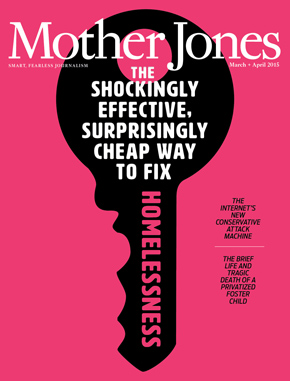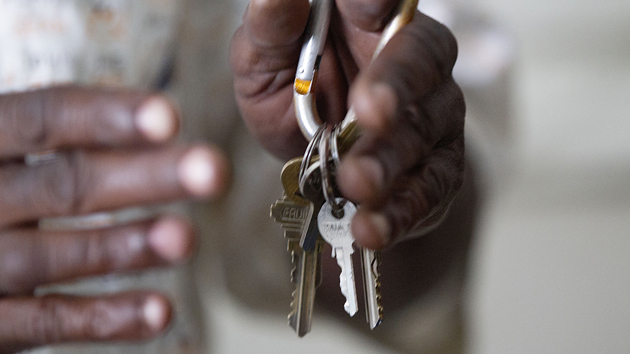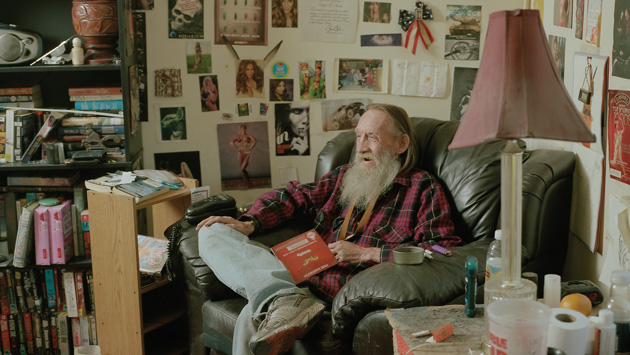Like San Francisco, Silicon Valley is known for the glaring divide between its tech-fueled affluence and its persistent homelessness problem. An estimated 6,500 homeless people live in Santa Clara County, California, an area that stretches from suburban Palo Alto to the garlic fields of Gilroy. Seventy percent of its homeless population lives on the streets, in cars, or in parks, often in plain sight of glittering corporate campuses. In late 2014, more than 300 people were cleared out of the Jungle, a large encampment not far from Apple’s headquarters in San Jose. And while the county’s homeless population has been declining, there just aren’t enough places to give everyone housing.

Enter the geeks. Earlier this year, Santa Clara County unveiled a sophisticated algorithm that could revolutionize the way homeless people are picked for housing. The algorithm, known as the Silicon Valley Triage Tool, draws on millions of pieces of data to predict which homeless individuals will use the most public services like emergency rooms, hospitals, and jails. The researchers behind the project calculate that identifying and quickly housing 1,000 of these high-cost people could save more than $19 million a year—money that could be rolled into providing more housing for homeless people.
“Instead of just throwing money at the problem in a scattershot approach, we need to invest where we’re going to see the biggest gains,” explains Jennifer Loving, the director of Destination:Home, the public-private partnership that cosponsored the development of this data-driven model. “Maybe it sounds very Silicon Valley, but it just seems obvious.”
Homelessness in major California counties, 2015
Santa Clara County’s model is focused on reducing costs while better serving chronically homeless people. The 10 percent of homeless people with the highest public costs accounted for a whopping 61 percent of the county’s expenditures on homelessness in 2012; the top 5 percent accounted for 47 percent of costs.
Those stats came to light after Santa Clara County commissioned an unprecedented breakdown of its public expenditures on the 104,000 people who had been homeless in the county over a six-year period. Conducted by the Los Angeles-based Economic Roundtable, the 2015 study concluded that the county’s 2,800 most persistently homeless people used an average of $83,000 in public services a year, far exceeding the cost of simply providing them with permanent supportive housing. The researchers found 26 people who had annual costs of more than $300,000. One was a 32-year-old man with schizophrenia and a musculoskeletal disorder who spent 322 days in the hospital and 10 days in jail in a single year, at a cost of $1.5 million.
Most cities and counties don’t track how much they spend on individual homeless people. Homeless people’s personal data tends to be scattered across entities like housing programs, hospitals, police departments, and drug and alcohol treatment programs. (A recent audit of San Francisco’s homelessness services noted that its programs maintain multiple unlinked and incompatible data systems.) The Economic Roundtable processed more than 25 million health, law enforcement, and social-service records that documented individuals’ demographics, medical and mental health diagnoses, ER and hospital visits, arrests, and jail time. Compiling and analyzing the data while adhering to medical privacy laws was “a huge lift” that took more than three years, says Ky Le, the director of the county’s Office of Supportive Housing.
Yet finally having that comprehensive data allowed Le to start rethinking how he placed people in housing. The county’s approach builds upon a philosophy known as Housing First, which centers on giving chronically homeless people long-term housing as quickly as possible, with few if any strings attached. When San Francisco and New York pioneered the Housing First model in the 1990s and 2000s, critics said it coddled drunks and drug abusers. Yet experience has consistently shown that prioritizing housing for the most distressed homeless people makes it easier to address their other needs, such as medical care and mental health. And it saves taxpayers money—often a lot of money. After San Francisco placed 162 people with unusually high service costs into supportive housing, it reported slashing their annual service costs by 72 percent, or $21.4 million. Similar outcomes have led to the adoption of Housing First in cities such as Seattle and Salt Lake City.
But Housing First has limits. The supply of supportive housing cannot match demand, particularly in the insanely expensive real estate markets of San Francisco and Silicon Valley. And according to the Economic Roundtable, the current criteria for assigning housing may unintentionally overlook people with acute problems. Like most local governments, Santa Clara County has based housing preference on two factors: how long people have been homeless, and their self-reported medical and mental health issues (known as a “vulnerability index survey”). Le knew that approach wasn’t perfect. “Those are definite indicators of need,” he says, “but it didn’t necessarily mean that everyone we housed were the highest users or even frequent users of our public safety net services. We wanted a good tool that would really allow us to find people who were going to use those services a lot.”
Digging into data to better serve the homeless population has been tried elsewhere. San Francisco’s Department of Public Health, which oversees a third of the city’s 5,000 supportive housing units, uses health and jail records to identify the highest-cost homeless people and prioritize them for housing. Social workers at Los Angeles hospitals use a similar tool, as does the Department of Veterans Affairs. Yet unlike Santa Clara County’s model, none of these systems is predictive: They can identify homeless people who cost a lot right now, but not necessarily those who are most likely to run up the most future costs.
Those are the people that Santa Clara County wanted to find. Using the data compiled on the county’s homeless population, Daniel Flaming, the Economic Roundtable’s president, built a predictive analytic statistical algorithm based on 38 variables that can predict if someone will fall into the group of homeless people with the highest costs. (Likewise, the model tries to eliminate false positives—people with characteristics of the highest-cost group who will not have high costs.) The most predictive variables include continuous homelessness for three or more years, chronic medical conditions, schizophrenia, drug or alcohol abuse, and frequent ER admissions and hospital stays, as well as repeated arrests and jail time. “It is usually not just one problem—it is a combination,” Flaming says.
Characteristics of the most vulnerable homeless people
This analysis is the backbone of the Silicon Valley Triage Tool, which calculates an individual’s probability of accruing high public service costs. Using the tool could reduce Santa Clara’s annual spending on homelessness by 4 percent, Flaming estimates. That’s not an insignificant figure when you consider its total spending is about $520 million annually. (San Francisco says it spends more than $200 million a year on homelessness, though it used a different methodology than Santa Clara to reach that figure.)
The promise of using big data to combat homelessness is hard to resist in Silicon Valley. Destination:Home’s funders include tech giants such as Google, EBay, Cisco, and Symantec. Last week, Google announced a $1 million grant to Destination:Home to help develop an algorithm that will prioritize homeless people for temporary and transitional housing. “Obviously we are a data company and an innovation company, so we really like to see data being used,” says Justin Steele of the company’s philanthropic arm, Google.org. “That is why we were so excited about the Destination:Home project—it was really tied to outcomes.”
Yet advocates of this approach insist that it’s not just efficient, but also humane. “It shouldn’t just be about cost,” says Loving of Destination:Home. “But we know that there’s a cohort of people who are jamming up the system, who are overutilizing services, who are suffering on a daily basis, and housing is the medicine they need. So how do we find them?”
Though Santa Clara County hasn’t decided exactly how it will use the Silicon Valley Triage Tool to make housing decisions, it is unlikely to completely eliminate human discretion from the process. For one thing, the tool may not flag homeless families, whose children may not cost much in the short term but suffer serious long-term consequences from growing without a stable home. And the tool could conceivably miss some high-needs homeless people who might be easily identified by doctors and caseworkers.
There are also questions about whether the tool’s algorithm emphasizes savings at the expense of equity. It gives higher scores to men because they tend to rack up higher public service costs. Conversely, it identifies homeless women as less expensive. (Latinos, Asian Americas, and immigrants are also less likely to be in the high-cost group.) Factoring gender into medical diagnoses isn’t unusual, but it becomes harder to justify when the treatment in question is housing. Clinical methods “should be exported to prioritizing housing to improve health outcomes,” says Joshua Bamberger, the medical director of the housing and urban health section of the city’s Department of Public Health. “However, the affordable housing system should be protected from any bias. So which is our system?”
San Francisco is grappling with these questions as it seeks to compile its own comprehensive data on its homelessness expenditures and revamp its system for assigning housing. San Francisco’s new prioritization system “will likely be algorithmic,” says Megan Owens Faught, a program manager in the housing and homelessness department of the San Francisco Human Services Agency.
Flaming, of the Economic Roundtable, says California’s agencies already have all the information they need to develop a statewide database similar to the one in Santa Clara County. That way, any city or county could use his data-driven approach to target people with the most urgent need for housing. “It would be effective and quite accurate,” he says. “This is by far the way you get the most bang for your buck.”
Top image: An abandoned campsite in the Jungle, the San Jose encampment cleared out by police in late 2014. Lipo Ching/TNS/ZUMA Wire














